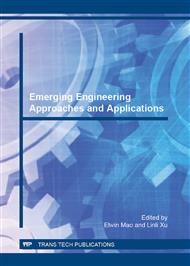p.198
p.204
p.209
p.214
p.221
p.226
p.230
p.236
p.241
The Comparison of the Effect of Haimming Window and Blackman Window in the Time-Scaling and Pitch-Shifting Algorithms
Abstract:
The real-time pitch shifting process is widely used in various types of music production. The pitch shifting technology can be divided into two major types, the time domain type and the frequency domain type. Compared with the time domain method, the frequency domain method has the advantage of large shifting scale, low total cost of computing and the more flexibility of the algorithm. However, the use of Fourier Transform in frequency domain processing leads to the inevitable inherent frequency leakage effects which decrease the accuracy of the pitch shifting effect. In order to restrain the side effect of Fourier Transform, window functions are used to fall down the spectrum-aliasing. In practical processing, Haimming Window and Blackman Window are frequently used. In this paper, we compare both the effect of the two window functions in the restraint of frequency leakage and the performance and accuracy in subjective based on the traditional phase vocoder[1]. Experiment shows that Haimming Window is generally better than Blackman Window in pitch shifting process.
Info:
Periodical:
Pages:
221-225
Citation:
Online since:
September 2011
Authors:
Keywords:
Permissions:
Share:
Citation:


